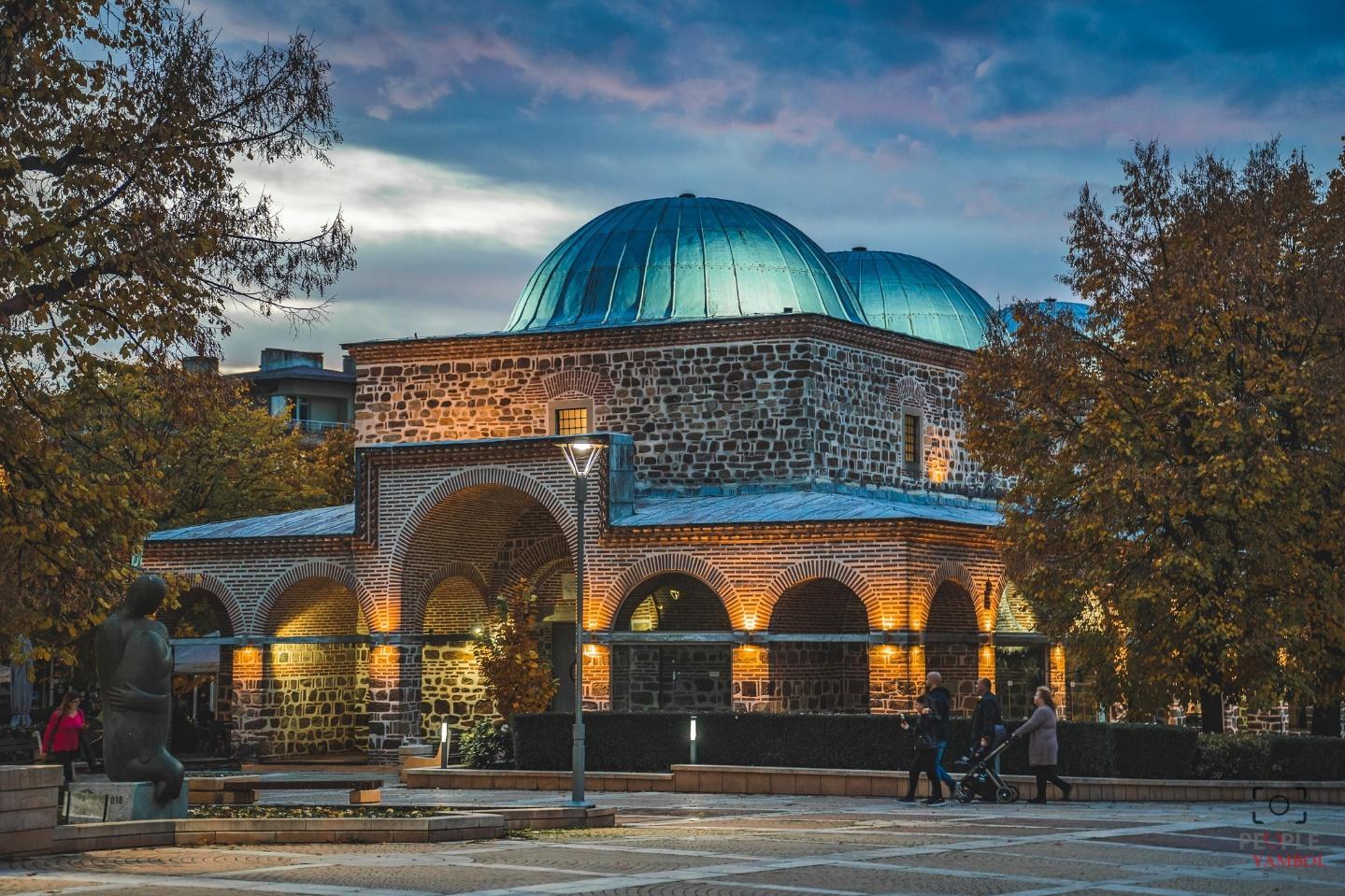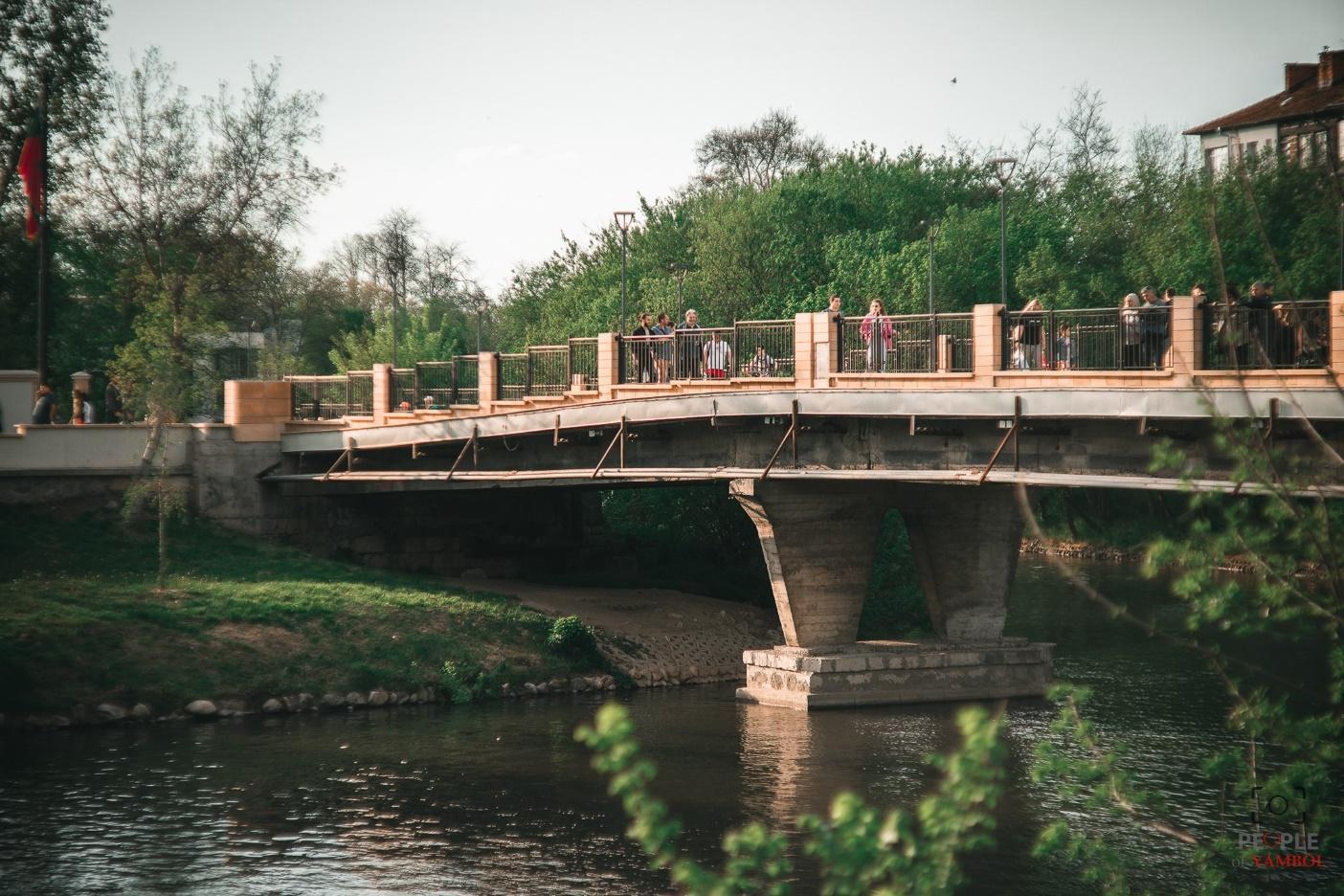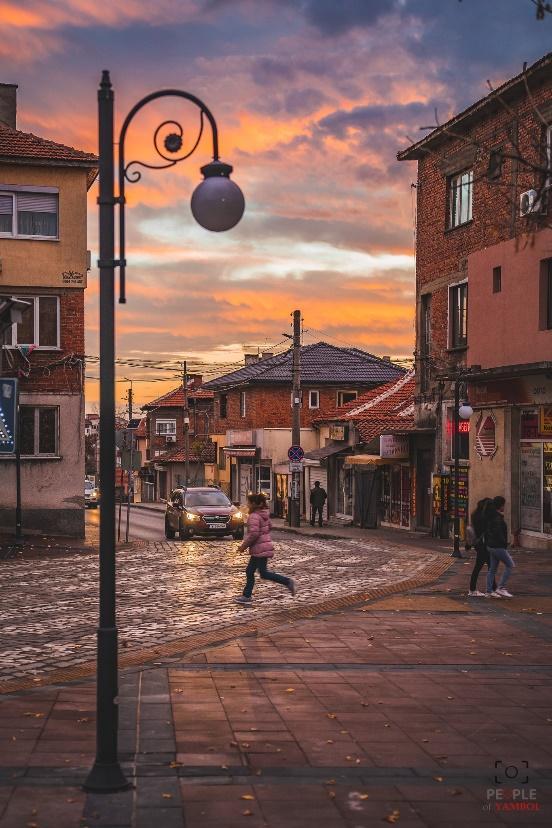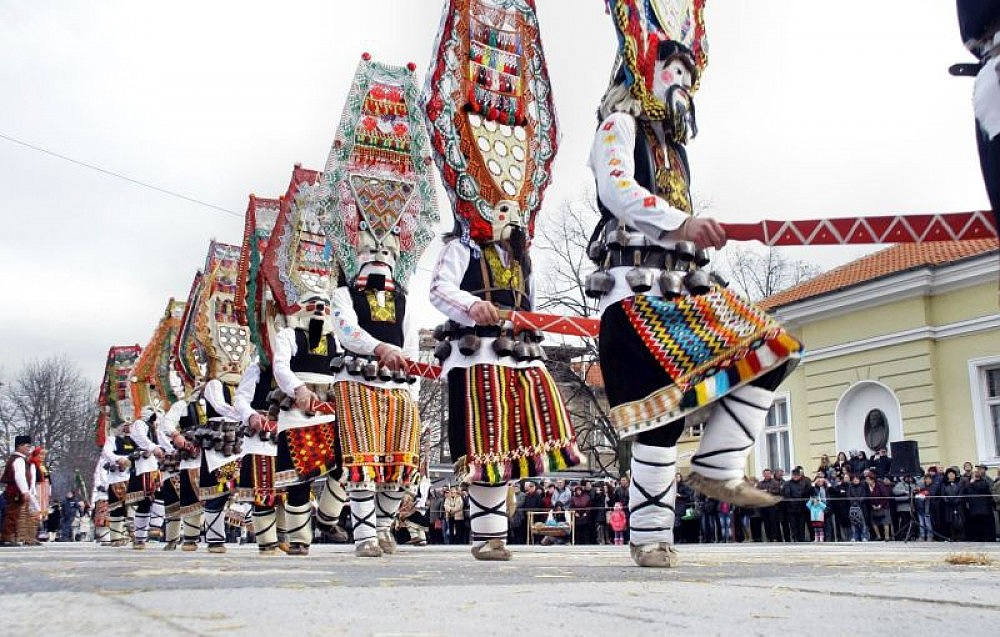Yambol is located on a fertile plain in the southeastern part of Bulgaria. The Bulgarian and Turkish names of the city Yambol and Yanbolu come from the Greek Diampolis (The City of Gods).
The city is located about 100 km west of the port city of Burgas, on both banks of the Tundzha River
Yambol sits on the ruins of the Thracian settlement of Kabile, a fortress that was strengthened by Philip the Great (Alexander’s father). Later, on these foundations was built the city of Yampolis, from which its current name is derived. Near it, 14 km to the south, there are still the remains of the wall built as a buffer and protector against the invasions of the Byzantine armies. This is the longest wall in Bulgaria, with a length of 131 km, built during the time of the first Bulgarian kingdom. With the Ottoman occupation, in the 14th century, many Muslims settled in the city, who made up the majority of the population until 1878.
The city of Yambol is the continuation of the ancient city of Kabile, which was destroyed during the invasion of the Avars in 587. For a while, Sultan Murad I lived in Kabile, a small village known as Tavşantepe by the Turks. The name Yambol is first seen in the records as Danbuli in 1049 as the place where Konstantinos Arianitis was defeated by the Pechenegs. In 1094, “Dampolis” surrendered to the Cumans. Around 1150 Sharif al-Idrisî spoke of Danbuli as a small but beautiful settlement on the plain. In 1304, the Bulgarian Tsar Theodor Svetoslav took the city from the Byzantines. In 1331-1332, the Byzantines gave the city to the Bulgarians as a result of barter with Ankiyalos, the port city on the Black Sea coast. Until the Ottoman conquest, the city remained in the hands of the Bulgarians as a small but very powerful fortress. As a medieval Bulgarian/Byzantine city, Yambol was located in the narrow curve of the Tundzha river. Excavations in 1978-1981 shed light on the foundations of this city: a square of 100 × 100 meters, an area of 1 hectare, construction coinciding with the decades before and after 1000. Around 1200 this castle was enlarged from the west side. There was a large cemetery to the east of the castle, which was probably the slum part.
It is not clear exactly when Yambol was captured by the Ottomans. While it was said that it was conquered in 1365 by the troops under the command of Timurtaş Pasha, it was later claimed that this happened in 1373. The second date is more likely to be the correct one. Yambol resisted from the first days of spring to the middle of summer, and the extreme heat caused the food and water to deteriorate and the epidemic disease that followed forced the defenders of the city to surrender. Hodja Sadeddin Efendi, one of the Ottoman historians, described the event in a similar way to what Kantakouzenos told two centuries ago. It is remarkable in this sense that the castle was not destroyed after the conquest. In 1410 Musa Çelebi resided in Yambol. It is possible that the first parts of the Eski Mosque here were built at the beginning of Ottoman rule (1375-1385). In terms of the plan, it bears a close resemblance to the Orhan Gazi Mosque in Bilecik, built in 1330-1340, and the Hoca Yadigar Mosque, built in 1374 in İnönü. The first information about the social and physical condition of Yanbolu is in a cadastral record dated 1457 (Istanbul Municipality Atatürk Library, Muallim Cevdet, nr. O. 89). Accordingly, there were 711 Muslim and fifty-seven Christian households in the town; Fourteen of the Christians were voynuks who were in semi-military service in the Ottoman army. According to these figures, the total population reached around 4000. Muslims made up 94%, an indicator of a large Turkish migration flow towards here.
In 1481 the sufi and scholar Sheikh Mehmed Noktacızâde had a large domed mosque and a dervish lodge built in Yambol, on the site of the medieval castle, and added a library to it. He built houses, shops, and gardens in the city. A Muslim neighborhood emerged around the mosque. At the beginning of the XVI century, the Vizier (Vezir) Atik Ali Pasha had a large covered bazaar built in Yambol to encourage trade and to provide income for his foundations in Istanbul. Over the course of the XVI century, Eskicami mosque was expanded with six vaulted sections to meet the needs of the ever-increasing number of the Muslim congregation. Throughout the XVI century, the situation in Yambol gradually improved. According to the censuses of the end of the XVI century (1595), there were 407 Muslim, 110 Christian, seven Gypsy, and five Jewish households (total town population: around 2700) in Yambol district, which was subject to the Silistra sanjak. Among the Christians, there was still a considerable group of voynuks. The proportion of Muslims had declined from 94% in 1457 to 77%. Meanwhile, there were three Cuma mosques in Yanbolu and eight mosques named after Mustafa Ağa’s Mosque-i Atik, Bali Subaşı Mosque, and Şeyh Noktacı Mosque. While there should have been masjids in the other six neighborhoods, their names were not mentioned in the records.

Evliya Çelebi, who came to Yambol at the beginning of 1077 Zilkade (May 1667), describes it as a prosperous and well-built city with 3500 houses, 280 shops, seven mosques, three baths, three madrasahs, a covered bazaar, and inns. The city was divided into seventeen Muslim, one Christian, and one Jewish quarters. Evliya Çelebi also states that he admired the large covered bazaar Bezisten: “There is a big bazaar with four iron doors, the only example of its kind in the country. All kinds of valuables can be found in the piles of trinkets here” and that the Eskicami had a rectangular and tower-like minaret; It includes the text of the Sofular Mosque and the inscription of one of the baths. In this inscription, it is recorded that it was built by Murad in 838 (1435). It is clear that Evliya Çelebi’s figures regarding the number of houses were exaggerated. On the other hand, in the official records of the madrasas in Rumeli around 1660, it is mentioned that there was only one madrasah (Kara Ali Bey Madrasa) in Yambol.
Yambol’s economy showed rapid growth and development throughout the XVIII century. French consul Peysonnel mentions that there was considerable export to Crimea every year. Again, a significant amount of leather was produced in the city, and there was a lively trade in fur manufacturing, tailoring, hat (kalpak) making, copper making, pottery making, halva making, woolen and cotton clothing, and honey. The production of kebe, a kind of thick and coarse cloth, was very famous. Such fabrics woven in Thrace and the Balkans were called “Yanbolu kebesi” and were very popular in Ottoman markets. Colonel G. Eneholm, a member of the Russian general staff who stayed in the city for a long time in 1830, stated that most of the part of the city bearing the name of Old Yanbolu (Yampolis) was located on a high plain on the left bank of the Tundzha river, and on the opposite shore, on a wide plain, the new Yanbolu/Kargon. According to him, the old city had eleven mosques, 1050 Turkish and 508 Bulgarian households, and 148 Jewish households from Spain. A large stone structure, the caravanserai could house 500 horses; There are also three slaughterhouses and pastrami workshops where 8,000 animals were slaughtered every year. In the new part of the city (Kargon), there are two small churches, fifteen Turkish and 510 Bulgarian households, seven inns, and a bazaar with 300 shops. Thus, the city has a total population of 11,600 people consisting of 6000 Turks, 5000 Bulgarians, and 600 Jews – in a total of 2229 households. From this information, it is understood that 52% of the population of Yambol were Muslims and 43% – were Bulgarians. Eneholm also draws attention to the economic activity of the city. Sahtiyan, unprocessed cotton and linen clothing, woolen blankets, suede leather, pastrami, raw leather, and wool are the leading production and imports. Large quantities of cattle were sent to Istanbul. The Yambol region is rich in livestock; In addition, plenty of rye, barley, wheat, oats, and rice were grown.
Before and after the wars of 1828-1829 and as a result of the Russian occupation, many Muslim people either fled to Istanbul or Anatolia or migrated. The results of these can be seen in the Edirne Yearbook dated 91 (1874): Here, a total of 4908 male population, 1525 Muslims and 3383 non-Muslims, fourteen large mosques, one masjid, two churches, five cellars, one synagogue, twenty-four inns, three baths, 622 stores, and 622 shops were mentioned. Thus, Muslims regressed to 25% of the total population and their places were filled by Bulgarians from the surrounding regions. Known for his travels in European Turkey, James Baker describes Yambol as a prosperous city with a population of 10,000 until by end of the Ottoman period.
After the ’93 War, Yambol and its surroundings were included in the Şarkîrumeli region. It joined the new Bulgarian State in 1885. In the Bulgarian census of 1888, it is seen that 8825 of the total population of 11,241 were Bulgarians, 1252 Turks, and the rest Spanish Jews, Greeks, and Gypsies. The Muslim part of the population fell to 11% of the total population. In the following years, although the Muslim and Jewish population of Yambol remained the same, the Bulgarian population gradually increased and spread over a wide area. In 1926, there were 1134 Turks and 1162 Jews among the population of 24,920 people. In the 2000s, the population approached 100,000 people. In the 1970s, two Ottoman monuments, the grand bazaar, and the Eskicami mosque were restored very well. After the fall of communism, the mosque was given back to the small Muslim community in the city and reopened for worship. The restoration and rebuilding of the covered bazaar (established between 1509 and 1510) were one of the biggest and most successful projects of the 1970s. The covered bazaar Bezisten, which is located at the focal point of the city, still maintains its old function. It was called the apple of the eye of trade in the Ottoman Empire. However, today it mainly serves tourists and local people. There is also a museum where the pieces bearing traces of the past are presented by the Bulgarian Ministry of Culture.
Today Yambol is one of the centers of trade in wine production, the food industry, and agricultural products, with factories producing textile products and tools used in shoemaking. In the 2001 Bulgarian census, the population of Yambol province was 156,000, and the population of Yambol, the center of the province, in 2005 was 86,000. Today, between 3700-4400 Muslims-Turks and around 3000 Gypsies live in Yambol. The other part of the population is completely Bulgarian.
XVI Şeyh Kemaloğlu Beyânî, one of the Ottoman poets of the 19th century, was born in Yambol.

The Jewish community
Jews lived in Yambol even before the Ottoman occupation. We can conclude this from the existence of a neighborhood and a synagogue in Istanbul called “Yanbolu”, which indicates that Jews from this city were transferred there to the new capital after it was conquered by Muhammad II “the conqueror” in 1453. The Jews who were forcibly brought to occupied Istanbul were called “Surgun” – “brought by force.” Either way, this indicates that Jews lived in Yambol even before the 14th century, but we have no reliable information on when or where they came from.
According to various traditions, the first Jews arrived in the ninth century, during the time of the First Bulgarian Kingdom. At the time of the occupation of the city by the Ottomans, in 1396, there was already a Jewish community there.
Thanks to the development of internal trade during Ottoman rule, the city was included among the new trade centers. Jewish craftsmen and merchants appeared.
In the middle of the 15th century, Rabbi Shmuel Frans of Vidin, the author of the “Sefer HaZikron” came to Yambol, and he served as the rabbi of the Romaniot community only. There are no details about the organization of the community in the 15th and 16th centuries, but, as mentioned, there is evidence of its existence.
From the end of the 15th century, the Jews lived on one side of the Tunja River, which crosses the city, and on the other side – the Bulgarians. The Turks – Muslims also lived in the Jewish quarter. This division remained in place until the immigration of the Jews to Israel, after the establishment of the state of Israel.
In 1835, Jews who came from Edirne settled in the city of Yambol, following the great fire that was in Edirne.
With the entry of the Russian army in 1877, during their war against the Ottoman Empire, the Jews temporarily abandoned Yambol. Upon their return, the community reorganized. According to a census from 1880, 606 Jews lived in the city at that time.
In 1900 Yambol was included in the list of 34 cities where organized Jewish communities existed.
During the Balkan Wars (1912-1913), the Yambol community numbered 1,600 people (out of a total of 15,750 inhabitants). Of the Jewish men, 167 were conscripted into the Bulgarian army. They supported 280 family members. For those in need, various charities managed to collect 5,200 French francs – 18.5 francs per person. The relatively high amount per capita indicates the difficult situation of the poor stratum of the community.
The Jewish community’s institutions included a cemetery, “Shevra Kadisha”, a synagogue, and a medical center. From the 1930s of the 20th century until the mass immigration to Israel, in the years 1948-1950, Rabbi Pinto served as the chief rabbi of the city, who died in Israel.
From the 60s of the 18th century, the Jewish children of the city were educated in “Meldar”, a traditional school. The children were able to acquire a general education at a school for boys of “Khil Yisrael Komelef” when it opened in 1881. When it opened, 117 students studied there, and the curriculum also included the teaching of Bulgarian and Hebrew. During the First World War, a Jewish elementary school was opened, held by the community. At that time there were about 1,000 Jews in Yambol.
As in other places, the Jews of Yambol were also affected by the wave of anti-Semitism that hit Bulgarian cities at the end of the 19th century and the beginning of the 20th century. In 1894 there was a blood plot and a Jew accused of murder was sentenced to three years in prison. In the same decade, two anti-Semitic pamphlets were published in the city, one of them under the name “The Rothschild Family”. An anti-Semitic newspaper (“Utziv”) began its appearance. Anti-Semitic riots hit the community again in 1903.
In September 1939, 1,193 Jews lived in Yambol.
The Holocaust period
In October 1940, after the outbreak of World War II, the Bulgarian government enacted the “Law for the Defense of the Nation”, whose regulations were put into effect in February 1941. The Jews were required to wear a yellow sign, resembling a button or a Star of David, their homes and businesses were marked, and they were expelled from higher education institutions. In March 1941, the German army entered Bulgaria. Jewish men were recruited into labor companies, employed in hard labor, and held in concentration camps for forced labor. In May 1943, about 20,000 of the Jews of Sofia were deported to other cities. The authorities ordered the deportees to be housed in Jewish homes only. The living conditions were difficult but the attitude of the Bulgarian population was sympathetic.
In 1948, the Jewish consistory sold the synagogue, built in 1896, to the army and it became a warehouse. In 1971 the Yambol municipality bought the building and after it was renovated and restored, it was converted into an art gallery. Remains of an ancient synagogue were discovered under it. The bath house, which was next to the synagogue, houses a cooperative factory for the production of shoes. The school, which was also built near the synagogue, was expanded and renovated and continues to be used as a school for Bulgarian children.
The old cemetery was destroyed and not a single tombstone was preserved. In 1972 a new cemetery was opened, but no tombstones were moved to it from the old cemetery.

The city of Yambol is permanently present on the cultural map of Bulgaria. As early as 1862, a library was established in the city. In 1921, the “Modern Theater” cinema was built. In 1949, the State Drama Theater was established, bearing today the name of the great Bulgarian actress Nevena Kokanova, and in 1957, the State Puppet Theatre.
In 1967, the Yambol Choir School “Prof. G. Dimitrov” was established, which made our city famous throughout Europe. The “Dianopolis” Chamber Orchestra, the Wind Orchestra, and the “Tunja” Folklore Ensemble have their performances in the city.
Yambol occupies a worthy place among the established festival cities in Bulgaria and abroad through various cultural forums: International masquerade festival “Kukerlandia”, National carol festival “Yambolsky Buenek”; Puppet – theatrical holidays “Mikhail Lakatnik”, Musical holidays “Golden Diana”, Theater holidays “Nevena Kokanova”.
“Kukerlandia” now takes place within three days, and the name “Kukerlandia” is a trademark of the municipality with a patent for the organization of the masquerade festival. Yambol is also a member of the Federation of European Carnival Cities.
Residents and guests of Yambol can visit the rich exposition of the Historical Museum, the “George Papazov” Art Gallery, see the unique wood-carved iconostasis in the “St. George” church – the work of masters from the Debar school, the restored Eski Mosque and Bezisten in the city center and the unique city park located on the island of the Tundzha river.

This article was originally published in Balkans in-site on December 13, 2022.
References
- מבול – Yambol (thebulgarianjews.org.il)
- Историческа справка – Община Ямбол (yambol.bg)
- YANBOLU – TDV İslâm Ansiklopedisi (islamansiklopedisi.org.tr)
- Photos: the Facebook page “People of Yambol”